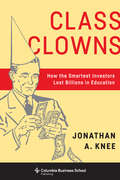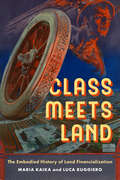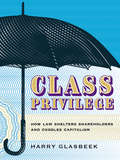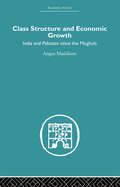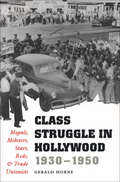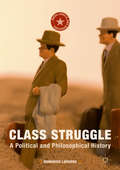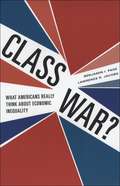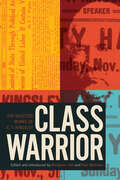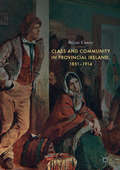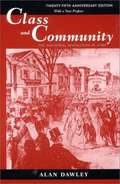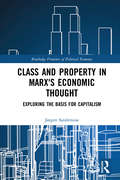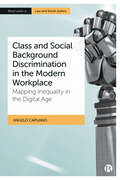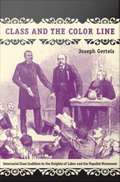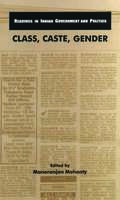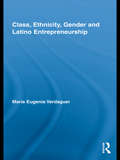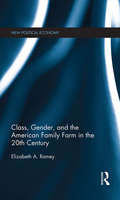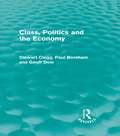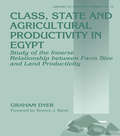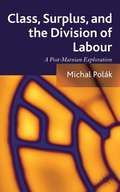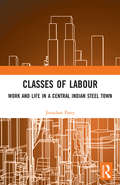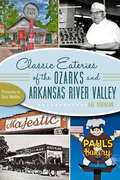- Table View
- List View
Class Clowns: How the Smartest Investors Lost Billions in Education
by Jonathan A KneeThe past thirty years have seen dozens of otherwise successful investors try to improve education through the application of market principles. They have funneled billions of dollars into alternative schools, online education, and textbook publishing. They have, with surprising regularity, lost their shirts.In Class Clowns, professor and investment banker Jonathan A. Knee dissects what drives investors' efforts to improve education and why they consistently fail. Knee takes readers inside four spectacular financial failures in education: Rupert Murdoch's billion-dollar effort to reshape elementary education through technology; the unhappy investors-including hedge fund titan John Paulson-who lost billions in textbook publisher Houghton Mifflin; the abandonment of Knowledge Universe, Michael Milken's twenty-year mission to revolutionize the global education industry; and the story of Chris Whittle, founder of EdisonLearning and a pioneer of large-scale transformational educational ventures, who continues to attract investment despite decades of financial and operational disappointment.Although deep belief in the curative powers of the market drove these initiatives, it was the investors' failure to appreciate market structure that doomed them. Knee asks: What makes a good education business? By contrasting rare successes, Knee finds a dozen broad lessons at the heart of these cautionary case studies. Class Clowns offers an important guide for public policy makers and guard rails for future investors, as well as an intelligent exposé for activists and teachers frustrated with the repeated disappointments to shake up education.
Class Clowns: How the Smartest Investors Lost Billions in Education (Columbia Business School Publishing Ser.)
by Jonathan A. KneeThe past thirty years have seen dozens of otherwise successful investors try to improve education through the application of market principles. They have funneled billions of dollars into alternative schools, online education, and textbook publishing, and they have, with surprising regularity, lost their shirts.In Class Clowns, professor and investment banker Jonathan A. Knee dissects what drives investors' efforts to improve education and why they consistently fail. Knee takes readers inside four spectacular financial failures in education: Rupert Murdoch's billion-dollar effort to reshape elementary education through technology; the unhappy investors—including hedge fund titan John Paulson—who lost billions in textbook publisher Houghton Mifflin; the abandonment of Knowledge Universe, Michael Milken's twenty-year mission to revolutionize the global education industry; and a look at Chris Whittle, founder of EdisonLearning and a pioneer of large-scale transformational educational ventures, who continues to attract investment despite decades of financial and operational disappointment.Although deep belief in the curative powers of the market drove these initiatives, it was the investors' failure to appreciate market structure that doomed them. Knee asks: What makes a good education business? By contrasting rare successes, he finds a dozen broad lessons at the heart of these cautionary case studies. Class Clowns offers an important guide for public policy makers and guardrails for future investors, as well as an intelligent exposé for activists and teachers frustrated with the repeated underperformance of these attempts to shake up education.
Class Meets Land: The Embodied History of Land Financialization (IJURR Studies in Urban and Social Change)
by Dr. Maria Kaika Luca RuggieroClass Meets Land reveals something seemingly counterintuitive: that nineteenth-century class struggles over land are deeply implicated in the transition to twenty-first-century financial capitalism. Challenging our understanding of land financialization as a recent phenomenon propelled by high finance, Maria Kaika and Luca Ruggiero foreground 150 years of class struggle over land as a catalyst for assembling the global financial constellation. Narrating the close-knit histories of industrial land, industrial elites, and the working class, the authors offer a novel understanding of land financialization as a "lived" process: the outcome of a relentless, socially embodied historical unfolding, in which shifts in land’s material, economic, and symbolic roles impact both local everyday lives and global capital flows.
Class Privilege: How Law Shelters Shareholders and Coddles Capitalism
by Harry GlasbeekCapitalism’s agenda is the endless pursuit of private accumulation of socially produced wealth. In our system, the corporation—created by law—is meant to hide this agenda, to distract us so that flesh and blood capitalists can do what they like. But when the workings of the corporation are examined, they reveal a betrayal of the very values and norms that, for their legitimacy’s sake, capitalists in our parts of the world purport to share. Harry Glasbeek highlights one of capitalism’s weak spots–the perverting economic, political, and ethical roles played by the prime instrument of private wealth accumulation: the legal corporation. Once the corporate mask is ripped off, those who hide behind it become visible. Stripped of their protective garb, the capitalist class will be just as naked as the rest of us are when we face their corporations.
Class Structure and Economic Growth: India and Pakistan Since the Moghuls
by Angus MaddisonThis book was first published in 1971.
Class Struggle in Hollywood, 1930-1950: Moguls, Mobsters, Stars, Reds, & Trade Unionists
by Gerald HorneAs World War II wound down in 1945 and the cold war heated up, the skilled trades that made up the Conference of Studio Unions (CSU) began a tumultuous strike at the major Hollywood studios. This turmoil escalated further when the studios retaliated by locking out CSU in 1946. This labor unrest unleashed a fury of Red-baiting that allowed studio moguls to crush the union and seize control of the production process, with far-reaching consequences. This engrossing book probes the motives and actions of all the players to reveal the full story of the CSU strike and the resulting lockout of 1946. Gerald Horne draws extensively on primary materials and oral histories to document how limited a "threat" the Communist party actually posed in Hollywood, even as studio moguls successfully used the Red scare to undermine union clout, prevent film stars from supporting labor, and prove the moguls' own patriotism.
Class Struggle in Hollywood, 1930–1950: Moguls, Mobsters, Stars, Reds, & Trade Unionists
by Gerald Horne&“A taut narrative in elegant prose . . . Horne has unearthed a vitally important and mostly forgotten aspect of Hollywood and labor history.&” —Publishers Weekly As World War II wound down in 1945 and the cold war heated up, the skilled trades that made up the Conference of Studio Unions (CSU) began a tumultuous strike at the major Hollywood studios. This turmoil escalated further when the studios retaliated by locking out CSU in 1946. This labor unrest unleashed a fury of Red-baiting that allowed studio moguls to crush the union and seize control of the production process, with far-reaching consequences. This engrossing book probes the motives and actions of all the players to reveal the full story of the CSU strike and the resulting lockout of 1946. Gerald Horne draws extensively on primary materials and oral histories to document how limited a &“threat&” the Communist party actually posed in Hollywood, even as studio moguls successfully used the Red scare to undermine union clout, prevent film stars from supporting labor, and prove the moguls&’ own patriotism. Horne also discloses that, unnoticed amid the turmoil, organized crime entrenched itself in management and labor, gaining considerable control over both the &“product&” and the profits of Hollywood. This research demonstrates that the CSU strike and lockout were a pivotal moment in Hollywood history, with consequences for everything from production values, to the kinds of stories told in films, to permanent shifts in the centers of power.
Class Struggle: A Political and Philosophical History (Marx, Engels, and Marxisms)
by Domenico LosurdoAvailable for the first time in English, this book examines and reinterprets class struggle within Marx and Engels’ thought. As Losurdo argues, class struggle is often misunderstood as exclusively the struggle of the poor against the rich, of the humble against the powerful. It is an interpretation that is dear to populism, one that supposes a binary logic that closes its eyes to complexity and inclines towards the celebration of poverty as a place of moral excellence. This book, however, shows the theory of class struggle is a general theory of social conflict. Each time, the most adverse social conflicts are intertwined in different ways. A historical situation always emerges with specific and unique characteristics that necessitate serious examination, free of schematic and biased analysis. Only if it breaks away from populism can Marxism develop the ability to interpret and change the world.
Class War? What Americans Really Think about Economic Inequality
by Benjamin I. Page Lawrence R. JacobsIn Class War the authors present compelling evidence that most Americans favor free enterprise and practical government programs to distribute wealth more equitably.
Class Warrior: The Selected Works of E. T. Kingsley
by Eugene Thornton KingsleyIn October 1890, Eugene T. Kingsley’s life changed irrevocably when he was injured in a fall between two rail cars while working as a brakeman on the Northern Pacific Railway. Following the amputation of both his legs, Kingsley became radicalized and joined the Socialist Labor Party in San Francisco. His activism eventually brought him to Vancouver, B.C. where he founded the Socialist Party of Canada. A self-described “uncompromising enemy of class rule and class robbery,” Kingsley wrote prolifically on the exploitation of wage slaves by the capitalist class. Also known as a passionate orator, he went on to become one of the most prominent socialist intellectuals of his day. Class Warrior is a collection of Kingsley’s writing and speeches that underscores his tremendous impact on Canadian political discourse.
Class and Community in Provincial Ireland, 1851–1914
by Brian CaseyThis book explores the experience of small farmers, labourers and graziers in provincial Ireland from the immediacy of the Famine until the eve of World War One. During this period of immense social and political change, they came to grips with the processes of modernisation. By focusing upon east Galway, it argues that they were not an inarticulate mass, but rather, they were sophisticated and politically aware in their own right. This study relies upon a wide array of sources which have been utilised to give as authentic a voice to the lower classes as possible. Their experiences have been largely unrecorded and this book redresses this imbalance in historiography while adding a new nuanced understanding of the complexities of class relations in provincial Ireland. This book argues that the actions of the rural working class and nationalists has not been fully understood, supporting E.P. Thompson’s argument that ‘their aspirations were valid in terms of their own experiences’.
Class and Community: The Industrial Revolution In Lynn
by Alan DawleyThe author talks about labor and class issues, poverty and progress, and the contours of urban history in the city of Lynn at the beginning of Industrialism.
Class and Property in Marx's Economic Thought: Exploring the Basis for Capitalism (Routledge Frontiers of Political Economy)
by Jørgen SandemoseThis book presents the capitalist system as a function of the interaction of the three basic classes in the capitalist social formation. Through this, it shows how the corresponding conflicts and clashes of interests between those classes – industrial capitalists, wage labourers and landed proprietors – are unavoidable for understanding contemporary economic structures. Analysing these economic structures in relation to the forms of property ownership, as well as the typical processes of production connected with them, the author points out how Karl Marx’s theory of the capitalist social formation is closely connected with the emergence and existence of a national money market. At the same time, the book places a special emphasis on Marx’s theory of ground rent and modern landed property, an aspect misinterpreted by many authors; and through an evaluation of the most important Marxian categories regarding the analysis of the world market and its development, further emphasis is placed on the concept of differences in labour intensity between nations. This evaluation illustrates how the main categories of capital, wage labour and landed property acquire a completely different internal relation in poor countries compared to Western capitalist societies. Class and Property in Marx's Economic Thought aims at exposing a method for analysing contemporary capitalism through focusing on the basic relations of population groups in the capitalist social formation. It will be of interest to students and researchers within the field of economics, as well as other social sciences.
Class and Social Background Discrimination in the Modern Workplace: Mapping Inequality in the Digital Age
by Angelo CapuanoThis book exposes how inequalities based on class and social background arise from employment practices in the digital age. It considers instances where social media is used in recruitment to infiltrate private lives and hide job advertisements based on locality; where algorithms assess socio-economic data to filter candidates; where human interviewers are replaced by artificial intelligence with design that disadvantages users of classed language; and where already vulnerable groups become victims of digitalisation and remote work. The author examines whether these practices create risks of discrimination based on certain protected attributes, including ‘social origin’ in international labour law and laws in Australia and South Africa, ‘social condition’ and ‘family status’ in laws within Canada, and others. The book proposes essential law reform and improvements to workplace policy.
Class and the Color Line: Interracial Class Coalition In the Knights of Labor and the Populist Movement
by Joseph GerteisA lauded contribution to historical sociology, Class and the Color Line is an analysis of social-movement organizing across racial lines in the American South during the 1880s and the 1890s. The Knights of Labor and the Populists were the largest and most influential movements of their day, as well as the first to undertake large-scale organizing in the former Confederate states, where they attempted to recruit African Americans as fellow workers and voters. While scholars have long debated whether the Knights and the Populists were genuine in their efforts to cross the color line, Joseph Gerteis shifts attention from that question to those of how, where, and when the movements' organizers drew racial boundaries. Arguing that the movements were simultaneously racially inclusive and exclusive, Gerteis explores the connections between race and the movements' economic and political interests in their cultural claims and in the dynamics of local organizing. Interpreting data from the central journals of the Knights of Labor and the two major Populist organizations, the Farmers' Alliance and the People's Party, Gerteis explains how the movements made sense of the tangled connections between race, class, and republican citizenship. He considers how these collective narratives motivated action in specific contexts: in Richmond and Atlanta in the case of the Knights of Labor, and in Virginia and Georgia in that of the Populists. Gerteis demonstrates that the movements' collective narratives galvanized interracial organizing to varying degrees in different settings. At the same time, he illuminates the ways that interracial organizing was enabled or constrained by local material, political, and social conditions.
Class in Archaic Greece
by Peter W. RoseArchaic Greece saw a number of decisive changes, including the emergence of the polis, the foundation of Greek settlements throughout the Mediterranean and Black Sea, the organisation of panhellenic games and festivals, the rise of tyranny, the invention of literacy, the composition of the Homeric epics and the emergence of lyric poetry, the development of monumental architecture and large scale sculpture, and the establishment of 'democracy'. This book argues that the best way of understanding them is the application of an eclectic Marxist model of class struggle, a struggle not only over control of agricultural land but also over cultural ideals and ideology. A substantial theoretical introduction lays out the underlying assumptions in relation to alternative models. Material and textual remains of the period are examined in depth for clues to their ideological import, while later sources and a wide range of modern scholarship are evaluated for their explanatory power.
Class, Caste, Gender (Readings in Indian Government and Politics series)
by Manoranjan MohantyContemporary India’s political landscape is characterized by a great deal of social upheaval. This is the result of growing democratic consciousness which is increasingly conflicting with the forces of domination, authoritarianism and hegemony. Against this backdrop, this volume provides an understanding of these forces in both historical and analytical terms. In particular, the seminal essays gathered here explore the specificities of the crucial social categories of class, caste and gender, while simultaneously drawing attention to the arenas in which they intersect.
Class, Ethnicity, Gender and Latino Entrepreneurship
by María Eugenia VerdaguerDrawing on surveys and in-depth interviews, this book examines the social and economic relations of first-generation Latino entrepreneurs. Verdaguer explores social patterns between and within groups, situating immigrant entrepreneurship within concrete geographical, demographic and historical spaces. Her study not only reveals that Latinos' strategies for access to business ownership and for business development are cut across class, ethnic and gender lines, but also that immigrants' options, practices, and social spaces remain largely shaped by patriarchal gender relations within the immigrant family, community and economy. This book is a necessary addition to the literature on immigration, class, gender relations, and the intersectionality of these issues.
Class, Gender, and the American Family Farm in the 20th Century (New Political Economy)
by Elizabeth A. RameyIntegrating a focus on gender with Marx’s surplus-based notion of class, this book offers a one-of-a-kind analysis of family farms in the United States. The analysis shows how gender and class struggles developed during important moments in the history of these family farms shaped the trajectory of U.S. agricultural development. It also generates surprising insights about the family farm we thought we knew, as well as the food and agricultural system today. Elizabeth A. Ramey theorizes the family farm as a complex hybrid of mostly feudal and ancient class structures. This class-based definition of the family farm yields unique insights into three broad aspects of U.S. agricultural history. First, the analysis highlights the crucial, yet under-recognized role of farm women and children’s unpaid labor in subsidizing the family farm. Second, it allows for a new, class-based perspective on the roots of the twentieth century "miracle of productivity" in U.S. agriculture, and finally, the book demonstrates how the unique set of contradictions and circumstances facing family farmers during the early twentieth century, including class exploitation, was connected to concern for their ability to serve the needs of U.S. industrial capitalist development. The argument presented here highlights the significant costs associated with the intensification of exploitation in the transition to industrial agriculture in the U.S. When viewed through the lens of class, the hallowed family farm becomes an example of one of the most exploitative institutions in the U.S. economy. This book is suitable for students who study economic history, agricultural studies, and labor economics.
Class, Politics and the Economy (Routledge Revivals)
by Stewart Clegg Paul Boreham Geoff DowThis study, first published in 1986, provides a systematic account of the processes and structure of class formation in the major advanced capitalist societies. The focus is on the organizational mechanisms of class cohesion and division, theoretically deriving from a neo-Marxian perspective. Chapters consider the organization and structure of the ‘corporate ruling class’, the middle class and the working class, and are brought together in an overarching analysis of the organization of class in relation to the state and the economy. This title will be of particular interest to students researching the impact of recession on societal structure and the processes of political class struggle, as well as those with a more general interest in the socio-economic theories of Marx, Engels and Weber.
Class, State and Agricultural Productivity in Egypt: Study of the Inverse Relationship between Farm Size and Land Productivity
by Graham DyerThe inverse relationship between farm size and productivity is accepted as a "stylized fact" of agriculture in developing countries. This study uses Egyptian fieldwork data to examine factors creating this relationship, and the impact of economic and technological change on the relationship.
Class, Surplus, and the Division of Labour: A Post-Marxian Exploration
by Michal PolákThe traditional Marxian picture of a two-class polarisation seems far removed from today's diverse society. Re-examining the very foundations of the Marxian theory in the process, the author argues that important critiques can fruitfully be understood and to accomplish the goal, he extends the traditional concepts in innovative and original ways.
Classes of Labour: Work and Life in a Central Indian Steel Town
by Jonathan ParryClasses of Labour: Work and Life in a Central Indian Steel Town is a classic in the social sciences. The rigour and richness of the ethnographic data of this book and its analysis is matched only by its literary style. This magnum opus of 732 pages, an outcome of fieldwork covering twenty-one years, complete with diagrams and photographs, reads like an epic novel, difficult to put down. Professor Jonathan Parry looks at a context in which the manual workforce is divided into distinct social classes, which have a clear sense of themselves as separate and interests that are sometimes opposed. The relationship between them may even be one of exploitation; and they are associated with different lifestyles and outlooks, kinship and marriage practices, and suicide patterns. A central concern is with the intersection between class, caste, gender and regional ethnicity, with how class trumps caste in most contexts and with how classes have become increasingly structured as the ‘structuration’ of castes has declined. The wider theoretical ambition is to specify the general conditions under which the so-called ‘working class’ has any realistic prospect of unity.
Classic Eateries of the Ozarks and Arkansas River Valley (American Palate)
by Kat RobinsonIf life is a highway, food is the fuel. The restaurant cuisine of Arkansas was crafted by transportation--and by family heritage. From century-old soda fountains to heritage candy makers, Arkansas wine country and the birthplace of fried pickles, discover the delicious nooks of the Ozarks and scrumptious crannies of the Arkansas River Valley through this tasty travelogue. Learn how fried chicken came to a tiny burg called Tontitown. Discover a restaurant atop a gristmill with a history predating the Civil War. Dine where Bill Clinton, Sam Walton and Elvis Presley caught a bite to eat. Join author Kat Robinson and photographer Grav Weldon on this exploration of over one hundred of the state's classic and iconic restaurants.
Classic Fixtures & Hardware Company
by W. Carl Kester Craig StephensonClassic Fixtures & Hardware Company is a nationally-known manufacturer and distributor of kitchen and bathroom fixtures and trim, as well as lock sets and hardware for doors and windows. The company is privately held and has limited access to capital markets, so it depends on a loan facility with Southwest National Bank to finance its seasonal working capital needs. Level production and seasonal sales result in higher inventory levels and loan balances in the first half of the year and declining inventory and loan balances in the second half of the year. In 2008, Classic's loan balances have grown beyond forecasted amounts, and its CFO believes that Classic will likely be unable to pay off the loan balance before the end of the year. The CFO and a senior loan officer from Southwest have scheduled a meeting in order to determine both the reasons for this problem and what Classic might do to turn itself around.
